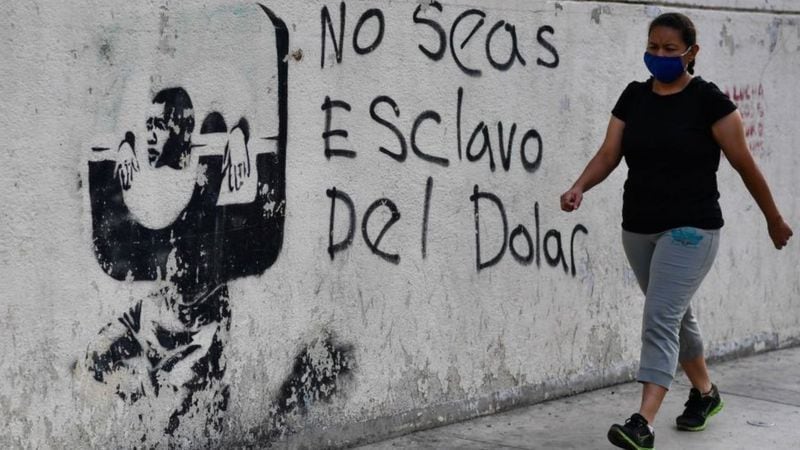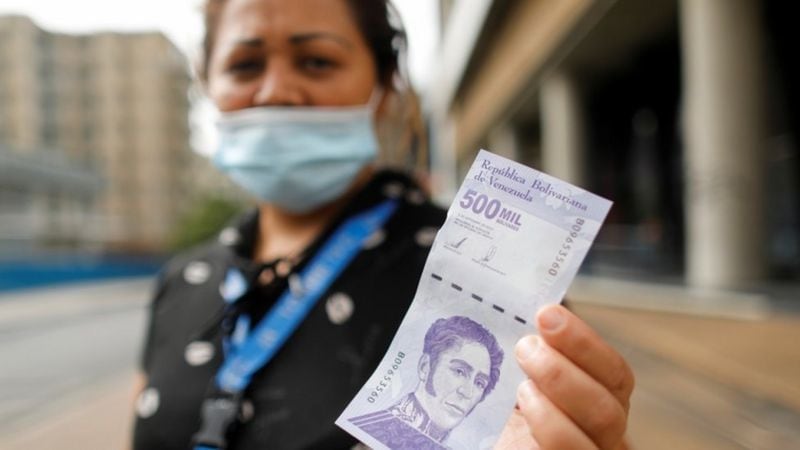Every morning, Carlos Ramos leaves home with the same goal: to get dollar bills.
He is one of the peddlers who sells change in Catia, one of the most popular markets in Caracas.
“Whoever gives me a US $ 20 bill, I give 18 US $ 1 bills.”
The difference is the profit of Carlos, who, like many in Venezuela today, lives, as he says, “On the hunt for change”.
But why is there someone who accepts a refund of US $ 18 when all they need to do is change US $ 20?
The answer is simple. Exchange is a rare commodity in Venezuela, where there is a de facto dollarization due to the loss of value of the bolivar.
And the lack of small bills makes many everyday transactions difficult to carry out, an especially pressing problem in everyday services like public transport.
Carlos Ramos makes money by exchanging high-denomination bills for US $ 1 bills.
Rafael Bravo, who covers the route between Catia and El Silencio, in the center of Caracas every day with his bus, explains to BBC Mundo the problems he faces.
“The ticket costs 150,000 bolivars ($ 0.07 exchange rate), but many people do not have bolivars in cash and cannot pay. Even if they had US $ 1 bills, that would be a lot more than it costs and I never have all the change to give it back to them. ”
His is one more example of the problems caused by the lack of change for Venezuelans.
The solution that Rafael has found is not very profitable. To those who do not have what to pay, it lets you travel for free. In other parts of the country, barter and other primitive forms of exchange are making their way.
How have you got here
Since 2017, Venezuela has been experiencing a process of hyperinflation, an accelerated rise in prices, which has caused its currency, the bolivar, to lose almost all its value.
As a consequence, the dollar is increasingly used and, according to the estimates of the Datanálisis consultancy, it already represents 64% of all transactions.

The dollar is a relief for many Venezuelans in the face of the depreciation of the bolivar. (AFP).
But, according to Guillermo Arcay, an economist at the Andrés Bello Catholic University of Caracas, “in Venezuela there is no formal dollarization such as that which has been carried out in other countries, which have cooperated with the United States Federal Reserve and have completed an orderly process through international payment channels ”.
Luis Vicente León, from Datanálisis, indicates that this lack of coordination with the US authorities “means that dollars do not enter the system in an orderly manner and the monetary cone that circulates is not planned in terms of use and demand for the banknote,” as if it happens, for example, in Panama, where a formal dollarization was carried out.
The socialist governments of Hugo Chávez and Nicolás Maduro they pursued the use of the dollar in Venezuela for years.
But in the last year the authorities have begun to tolerate it and Maduro has said that the US currency acts as a “safety valve” for the economy in the face of the “blockade” imposed by the United States in the form of sanctions.
Solutions
Currently, the dollar predominates, but given the scarcity of low-denomination dollar bills, the bolivar remains the reference currency for lower-value transactions. Even coins of US $ 0.25 are already beginning to be seen to facilitate the change.
This forces Venezuelans to adapt. The journalist Vanessa Silva explains that she has already learned at what level the needle of her car’s tank should be so that she has exactly $ 10 left to fill it, because she knows that at the pump they will not have change to give her the change and she will have to give it up for lost , if you don’t pay the exact amount.
She is not the only one who has had to sharpen her wits.

Almost everything is already sold in dollars in Venezuela. (EPA).
Recently, the Beco department store chain, when it did not have change in dollars, began to give customers vouchers that they could use as a means of payment for future purchases.
The National Superintendency for the Defense of Socioeconomic Rights (Sundde), a state body, acted quickly to stop this practice.
We are generating a prohibitive measure to @Stores_Beco, the company was conditioning the consumer, offering an unauthorized “return” mechanism better known as “VALE”, the fair exchange must be returned to the population. pic.twitter.com/FMP9yKh9f3
– Daniel Gomez (@danielgomezvzla) March 15, 2021
The authorities have also intervened against the pharmacy chain Farmatodo to return the change in dollars to customers.
The Superintendency of the Institutions of the Banking Sector (Sudeban) announced the entry into operation as of April 15 of a new payment modality called C2P (commerce to person) in which the establishment processes the payment directly at the customer’s bank.
This is part of Maduro’s strategy to promote the so-called “Digital bolivar”.
The president has pointed to the public transport system, which moves about three-quarters of all the bolivar bills that circulate in the economy, as the first measure, but the low connectivity in Venezuela raises doubts about its possible effectiveness.
Arcay explains that those most affected by the lack of exchange and the shortage of cash are “the Venezuelans who are not banked,” for whom many times there is no alternative but to give up what they need. “There are transactions that have simply disappeared. They no longer have a place ”.
The new banknotes
A possible help could be the new 200,000, 500,000 and one million bolivar bills, the highest nominal value in the history of this currency, which was recently presented by the Central Bank of Venezuela.

The new half-million bolivar bill is barely worth US $ 0.25. (Reuters).
It was interpreted as an attempt to resolve difficulties in lower value payments.
But, despite its high face value, the new one million bolivar bill has a real exchange value of just US $ 0.50, which will surely soon be further reduced due to the permanent depreciation of the bolivar.
Arcay points out that “they released some very tall bills that will actually fulfill the role of coins.”
The economist believes that, in any case, “it will be a solution for a few weeks, at most months.”

The three new banknotes presented by the Central Bank of Venezuela barely add up to US $ 1 together. (Central bank of Venezuela).
And an elusive solution for many, because cash in bolivars is also scarce.
The volume of bolivars in banknotes in the economy represents 2% of the money that circulates in the country. Two years ago it was equivalent to 7%, according to BCV data reported by Reuters.
Luis Vicente León says that it will not be the actions against businesses or removing zeros from their currency, as the Venezuelan government has done several times, that will return the value to the bolivar, and he calls for a radical change in economic policy.
“In reality, the value of a currency is based on the confidence it inspires, and in the current situation the chances of regaining confidence in the Venezuelan currency in the short term are nil.”

:quality(75)/cloudfront-us-east-1.images.arcpublishing.com/elcomercio/LUJLQOLXCJAEJFVQ4TRT7MTS4E.jpg)